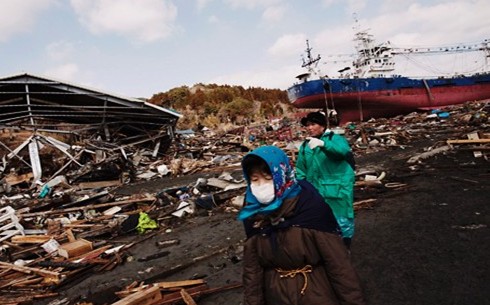
『日本大地震引发了人们对于灾难以及核能的新一轮思考,地震中人们面对灾难时的不同态度,也凸显出东西方文化的差异。』
A Tale of Two Cultures
地震背后的双重文化
March 20th, 2011 | From Newsweek

Rudyard Kipling famously said, “East is East, West is West, and never the twain shall meet.”
Yet since Japan’s devastating earthquake, the entire world has been riveted by heartbreaking images in the East revealing the horror of a nation whose northern coastline was reduced to rubble. Several nations have rallied behind Japan, sending in badly needed aid and other offers of help. The resounding support and generosity offered by the world community reveals the common bond, the humanity, that East and West share, contradicting Kipling.
But a closer look at the human dimensions of this historic crisis reveals subtle differences of culture, similarities of geography, and lessons for both sides of the world.
The sharpest link connecting East and West is simple geography. Like two Siamese twins joined at the hip, the Pacific's Ring of Fire forges a common destiny between East and West. Ninety percent of all earthquakes take place along this deadly ring, which extends from the Philippines and Japan to Alaska and South America.
But there are also subtle, revealing cultural differences between East and West in their reaction to tragedy.
In spite of monumental collapse and ruin, the Japanese politely wait in long lines for hours, without once complaining. Law and order are respected at every step. The Shinto-Buddhist tradition, which stresses social harmony and cohesiveness and looking out for your neighbor, is deeply ingrained in the culture.
This stands in sharp contrast to some of the spontaneous reactions that have flared in the West. In the U.S., for example, when Hurricane Katrina hit New Orleans in 2005, there was a rapid collapse of civil authority as society disintegrated into an orgy of chaos.
The origin for this difference probably has deep historical roots. Japan is ethically and socially quite homogeneous. The U.S., by contrast, is quite diverse, a country of immigrants patched together from all corners of the world, seeking a new life based on individual initiative and drive."
The difference between the East and West is also illuminated in comparing the reactions to twin earthquakes on each side of the globe, which provoked two very different responses and helped to shape national character.
In the U.S., it was the San Francisco earthquake of 1906, which set off raging fires that incinerated much of the city and did more damage than the quake itself. In Japan, it was the Great Kanto Earthquake of 1923, which leveled Tokyo and caused 140,000 casualties.
These twin earthquakes sparked two different responses. In Japan, there has been an almost obsessive attention paid to earthquakes. Earthquake drills are part of life in Japan, instilled in the memory of every child. The thousands of tiny earthquakes one experiences in Japan is a gentle reminder of the big one to come. And building codes are among the toughest in the world.
In the U.S., outside of California, there is relatively little focus placed on earthquake preparedness. It is especially hard for politicians to get worked up over an event that didn’t happen in their voters' lifetime.
And what also binds the East and the West is the grim shadow of The Big One. Ironically, in spite of the historic damage done by this earthquake, it is not The Big One. Some geologists fear that we might be overdue for another earthquake that shakes Tokyo to its foundations. The Big One that levels a city with 13 million people has yet to hit Tokyo.
In the U.S., a hypothetical 9.0 earthquake off Alaska or Washington might unleash a tidal wave that would plow into L.A. with a 15-foot-tall wave, flooding everything inland for two to three miles. Malibu and Orange Country would be especially hit hard.
And lastly, the final link between East and West is that this tragedy is sparking an international debate about the future of nuclear energy, precisely at a time when the great powers are looking at the energy problem. Germany put all nuclear extensions on hold. Decisions now made in the shadow of this crisis could determine energy policy for a generation.
Maybe it is time to revisit the Faustian Bargain.(683 words)
特别声明:①凡本网注明稿件来源为"原创"的,转载必须注明"稿件来源:育路网",违者将依法追究责任;
②部分稿件来源于网络,如有侵权,请联系我们沟通解决。
25人觉得有用
24
2011.10
『一系列的研究表明,肥胖及烟酒导致的癌症、糖尿病、心脏病等慢性疾病已不再是富人的专利,这些疾病正......
24
2011.10
『人们习惯于用隐喻的方式,以简单概念为基础去理解一个复杂的概念。在纷繁的世界中,这不失为一种勉强......
24
2011.10
『美国的慈善事业有着源远流长的历史,但慈善事业的实际成效却不及其所展示的那般卓越。专家呼吁,慈善......
24
2011.10
14.共七大――1945年4月23日至6月11日,中国共产党第七次全国代表大会在延安杨家岭中央大礼堂召开......
24
2011.10
10.遵义会议――1935年1月15日至17日,中共中央在遵义召开了政治局扩大会议。 会议内容:①会议......
24
2011.10
1. 中共一大――1921年7月:通过了《中国共产党的第一个纲领》和《中国共产党的第一个决议》。 ......